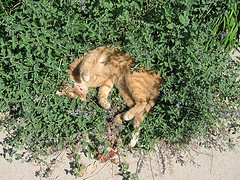Unlucky dogs get hit by cars. We have been seeing lots of unlucky dogs on the side of the road over the last week or so. While there are a number of unlucky female dogs, many of these are intact male dogs. They can smell a female in heat for 2 miles away and they don't know that the road is dangerous. They are also very likely to find another female in heat 2 miles from the current one and wander even further from home. It is also sad but important to note that every passer-by does not have your dogs best interest at heart when they see him. Some drivers view dogs in the road as an unnecessary distraction and not their problem- slowing down or swerving is not something they are willing to do. This what happened to the dog we saw get hit- no effort was made to slow down or get over by the driver. Some people shoot at dogs on their property to move them along to be someone else's problem. Our clinic has a resident old dog that was found wandering- he is full of buckshot and spent several miserable days on his own before he was rescued. It is important to remember not to rely on the kindness of others to take care of your wandering dog.
The best cure for a wanderer is a good fence. Electronic fences with remote collars are excellent dog containment devices if the dog is properly trained. You cannot, however, just install one and turn your dog loose with the collar on. If the untrained dog gets corrected (a mild electric shock) he will likely run out of the fenced area and be difficult to coax in. Once trained the dog runs toward the center of the yard and does not escape. Regular perimeter fencing or a kennel is also an excellent way to contain your dog. Just make sure that your fence is high enough or if your dog climbs your kennel is covered. Neutering and spaying also make dogs home bodies. Most wandering is done in pursuit of a mate. Many people worry that their dog will gain weight if spayed or neutered, but if you control what your dog eats you control his weight. This situation is easily controllable. It is certainly preferable to an intact dog crossing the road in front of a car that does not slow down.



